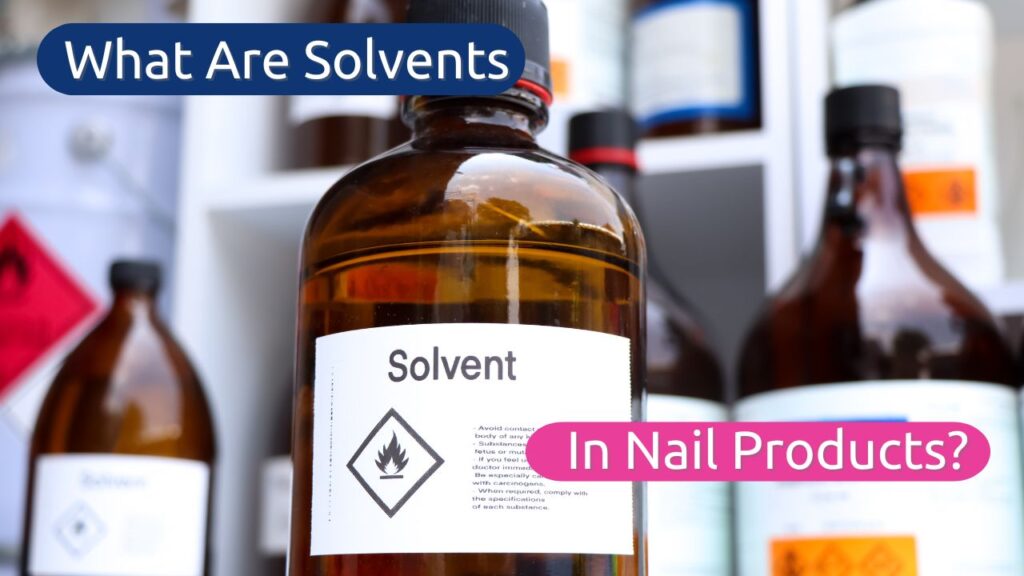Understanding the Chemistry Behind your Manicure
Ever looked at your favourite nail polish and wondered what makes it glide so smoothly onto your nails and then dry to a hard, glossy finish? It’s not magic, it’s science. And at the heart of that science are solvents. Now, what are solvents in nail products, exactly? Not something you chat about over brunch, I get it, but once you understand their role, you’ll never look at a manicure the same way again.
The Unsung Heroes of Nail Polish: Solvents Explained
Solvents are the invisible workhorses of the nail world. They’re the liquid components in your polish that do the heavy lifting, dissolving pigments, resins, plasticisers, and additives so that everything blends into one smooth, usable formula. Once you apply that polish, the solvents quickly evaporate into thin air, leaving behind a beautiful, solid film of colour.
To put it plainly, if nail polish were a cocktail, solvents would be the gin, essential, potent, and responsible for making everything else mix just right.
Without solvents, the polish wouldn’t flow out of the bottle, it wouldn’t spread evenly on your nail, and it certainly wouldn’t dry properly. The role of solvents in nails is both practical and aesthetic, affecting everything from drying time to texture, shine, and longevity.
☕ A Cup of Tea and Nail Polish?
Think of a solvent like the hot water in a cup of tea. You drop the tea bag in, and the water draws out all that flavour and colour, blending it into a smooth, aromatic brew. Then you drink it, and the liquid disappears, leaving you with the flavour and the caffeine buzz.
It’s the same with nail polish solvents, they’re the liquid that carries all the good stuff to your nail. Once the polish is applied, the solvent evaporates, and what’s left behind is a thin, colourful, glossy film ready to dazzle.
Why Solvents Matter: it’s More than Just Drying the Polish
When we ask, what are solvents in nail products, we’re really opening the door to a deeper appreciation of how nail coatings actually work. Here are just a few of the things solvents do:
- Dissolve and disperse colour pigments and resins, creating a uniform formula.
- Control viscosity, so you get that perfect thin layer that doesn’t streak or bubble.
- Help coatings self-level, making the surface smooth and professional-looking.
- Evaporate efficiently, allowing a hard, durable film to form.
- Influence drying time and adhesion, crucial for wear and finish.
In essence, they’re like backstage crew in a theatre. You may not see them, but without them, the show couldn’t go on.
What Are Solvents in Nail Products Doing in Different Nail Systems?
Solvents aren’t one-size-fits-all. Their role shifts depending on whether you’re working with traditional lacquer, gel polish, or hybrid formulas. Let’s break it down.
- Traditional Nail Lacquer
This is where solvents shine. Lacquer dries entirely through solvent evaporation. It’s why you can often smell it, solvents like ethyl acetate and butyl acetate are doing their job, vanishing into the air so the pigment can stay behind. - Gel Polish
Gels use far fewer solvents. They rely on UV or LED light to cure and harden. But a small amount of solvent is still involved in the base or top coat to help spread the product smoothly. - Hybrid Polish Systems
Think of these as the best of both worlds. They combine nail polish solvents with light-curing elements. This gives them the ease of application of traditional polish and the staying power of gel, while still depending on some evaporation.
Common Examples of Solvents in Nail Care
Here are the usual suspects you’ll find listed on the back of your nail product packaging:
- Ethyl Acetate – The primary solvent in many polishes. Evaporates quickly and has that sweet, nail-salon smell.
- Butyl Acetate – A bit slower to evaporate than ethyl acetate, helping with smooth application.
- Isopropyl Alcohol – Found in prep products and sometimes in polish to help thin it.
- Acetone – Often used in removers, but also plays a role in some polish formulas.
These examples of solvents in nail care vary in strength, speed of evaporation, and scent, but all serve to deliver, spread, and remove the product efficiently.
Safety first: using solvents wisely
It’s easy to forget that nail solvents, though effective, are still chemicals. Used properly, they’re safe, but it’s good to have a few best practices in mind:
- Work in a well-ventilated space. Inhaling solvent fumes over time isn’t great for your lungs.
- Apply thin layers. This helps solvents evaporate evenly and prevents bubbles or streaks.
- Avoid open flames. Some solvents are flammable (think acetone or ethyl acetate).
Also, keep an eye on product labels if you have sensitive skin or allergies. There are now more “low-odour” and “non-toxic” nail products hitting the market, which swap out harsher solvents for gentler alternatives.
Wrapping it up: a Little Chemistry Goes a Long Way
So next time you’re applying a fresh coat of polish, remember the invisible but powerful chemistry at play. Asking what are solvents in nail products is like asking how the stage gets set before a theatre performance, it’s the part that makes everything else possible. From the perfect flow to that satisfying dry-down, solvents are the reason your nails look salon-worthy in minutes.
Understanding them doesn’t just make you smarter, it might even make you better at applying polish. And hey, who doesn’t want fewer bubbles, faster drying, and a finish that lasts?


